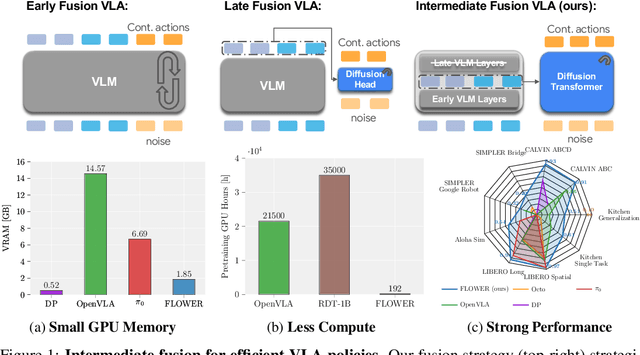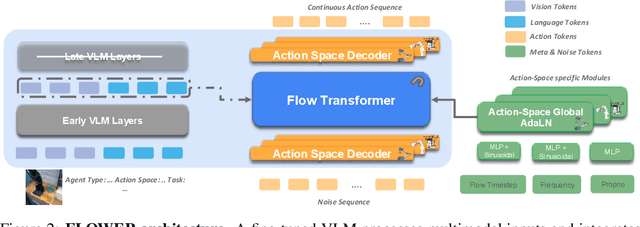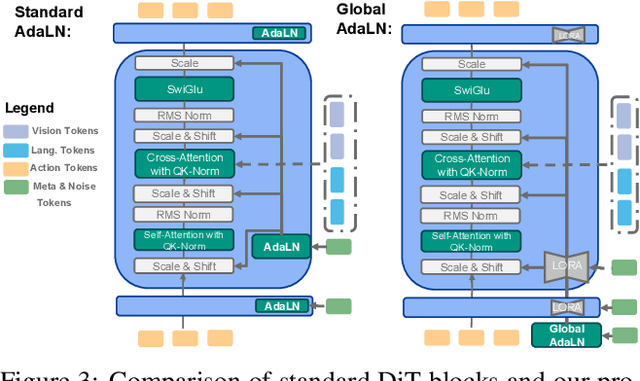Hongyi Zhou
PointMapPolicy: Structured Point Cloud Processing for Multi-Modal Imitation Learning
Oct 23, 2025Abstract:Robotic manipulation systems benefit from complementary sensing modalities, where each provides unique environmental information. Point clouds capture detailed geometric structure, while RGB images provide rich semantic context. Current point cloud methods struggle to capture fine-grained detail, especially for complex tasks, which RGB methods lack geometric awareness, which hinders their precision and generalization. We introduce PointMapPolicy, a novel approach that conditions diffusion policies on structured grids of points without downsampling. The resulting data type makes it easier to extract shape and spatial relationships from observations, and can be transformed between reference frames. Yet due to their structure in a regular grid, we enable the use of established computer vision techniques directly to 3D data. Using xLSTM as a backbone, our model efficiently fuses the point maps with RGB data for enhanced multi-modal perception. Through extensive experiments on the RoboCasa and CALVIN benchmarks and real robot evaluations, we demonstrate that our method achieves state-of-the-art performance across diverse manipulation tasks. The overview and demos are available on our project page: https://point-map.github.io/Point-Map/
FLOWER: Democratizing Generalist Robot Policies with Efficient Vision-Language-Action Flow Policies
Sep 05, 2025



Abstract:Developing efficient Vision-Language-Action (VLA) policies is crucial for practical robotics deployment, yet current approaches face prohibitive computational costs and resource requirements. Existing diffusion-based VLA policies require multi-billion-parameter models and massive datasets to achieve strong performance. We tackle this efficiency challenge with two contributions: intermediate-modality fusion, which reallocates capacity to the diffusion head by pruning up to $50\%$ of LLM layers, and action-specific Global-AdaLN conditioning, which cuts parameters by $20\%$ through modular adaptation. We integrate these advances into a novel 950 M-parameter VLA called FLOWER. Pretrained in just 200 H100 GPU hours, FLOWER delivers competitive performance with bigger VLAs across $190$ tasks spanning ten simulation and real-world benchmarks and demonstrates robustness across diverse robotic embodiments. In addition, FLOWER achieves a new SoTA of 4.53 on the CALVIN ABC benchmark. Demos, code and pretrained weights are available at https://intuitive-robots.github.io/flower_vla/.
BEAST: Efficient Tokenization of B-Splines Encoded Action Sequences for Imitation Learning
Jun 06, 2025Abstract:We present the B-spline Encoded Action Sequence Tokenizer (BEAST), a novel action tokenizer that encodes action sequences into compact discrete or continuous tokens using B-splines. In contrast to existing action tokenizers based on vector quantization or byte pair encoding, BEAST requires no separate tokenizer training and consistently produces tokens of uniform length, enabling fast action sequence generation via parallel decoding. Leveraging our B-spline formulation, BEAST inherently ensures generating smooth trajectories without discontinuities between adjacent segments. We extensively evaluate BEAST by integrating it with three distinct model architectures: a Variational Autoencoder (VAE) with continuous tokens, a decoder-only Transformer with discrete tokens, and Florence-2, a pretrained Vision-Language Model with an encoder-decoder architecture, demonstrating BEAST's compatibility and scalability with large pretrained models. We evaluate BEAST across three established benchmarks consisting of 166 simulated tasks and on three distinct robot settings with a total of 8 real-world tasks. Experimental results demonstrate that BEAST (i) significantly reduces both training and inference computational costs, and (ii) consistently generates smooth, high-frequency control signals suitable for continuous control tasks while (iii) reliably achieves competitive task success rates compared to state-of-the-art methods.
Demystifying the Paradox of Importance Sampling with an Estimated History-Dependent Behavior Policy in Off-Policy Evaluation
May 28, 2025Abstract:This paper studies off-policy evaluation (OPE) in reinforcement learning with a focus on behavior policy estimation for importance sampling. Prior work has shown empirically that estimating a history-dependent behavior policy can lead to lower mean squared error (MSE) even when the true behavior policy is Markovian. However, the question of why the use of history should lower MSE remains open. In this paper, we theoretically demystify this paradox by deriving a bias-variance decomposition of the MSE of ordinary importance sampling (IS) estimators, demonstrating that history-dependent behavior policy estimation decreases their asymptotic variances while increasing their finite-sample biases. Additionally, as the estimated behavior policy conditions on a longer history, we show a consistent decrease in variance. We extend these findings to a range of other OPE estimators, including the sequential IS estimator, the doubly robust estimator and the marginalized IS estimator, with the behavior policy estimated either parametrically or non-parametrically.
MonoMobility: Zero-Shot 3D Mobility Analysis from Monocular Videos
May 17, 2025Abstract:Accurately analyzing the motion parts and their motion attributes in dynamic environments is crucial for advancing key areas such as embodied intelligence. Addressing the limitations of existing methods that rely on dense multi-view images or detailed part-level annotations, we propose an innovative framework that can analyze 3D mobility from monocular videos in a zero-shot manner. This framework can precisely parse motion parts and motion attributes only using a monocular video, completely eliminating the need for annotated training data. Specifically, our method first constructs the scene geometry and roughly analyzes the motion parts and their initial motion attributes combining depth estimation, optical flow analysis and point cloud registration method, then employs 2D Gaussian splatting for scene representation. Building on this, we introduce an end-to-end dynamic scene optimization algorithm specifically designed for articulated objects, refining the initial analysis results to ensure the system can handle 'rotation', 'translation', and even complex movements ('rotation+translation'), demonstrating high flexibility and versatility. To validate the robustness and wide applicability of our method, we created a comprehensive dataset comprising both simulated and real-world scenarios. Experimental results show that our framework can effectively analyze articulated object motions in an annotation-free manner, showcasing its significant potential in future embodied intelligence applications.
Chunking the Critic: A Transformer-based Soft Actor-Critic with N-Step Returns
Mar 05, 2025Abstract:Soft Actor-Critic (SAC) critically depends on its critic network, which typically evaluates a single state-action pair to guide policy updates. Using N-step returns is a common practice to reduce the bias in the target values of the critic. However, using N-step returns can again introduce high variance and necessitates importance sampling, often destabilizing training. Recent algorithms have also explored action chunking-such as direct action repetition and movement primitives-to enhance exploration. In this paper, we propose a Transformer-based Critic Network for SAC that integrates the N-returns framework in a stable and efficient manner. Unlike approaches that perform chunking in the actor network, we feed chunked actions into the critic network to explore potential performance gains. Our architecture leverages the Transformer's ability to process sequential information, facilitating more robust value estimation. Empirical results show that this method not only achieves efficient, stable training but also excels in sparse reward/multi-phase environments-traditionally a challenge for step-based methods. These findings underscore the promise of combining Transformer-based critics with N-returns to advance reinforcement learning performance
X-IL: Exploring the Design Space of Imitation Learning Policies
Feb 19, 2025Abstract:Designing modern imitation learning (IL) policies requires making numerous decisions, including the selection of feature encoding, architecture, policy representation, and more. As the field rapidly advances, the range of available options continues to grow, creating a vast and largely unexplored design space for IL policies. In this work, we present X-IL, an accessible open-source framework designed to systematically explore this design space. The framework's modular design enables seamless swapping of policy components, such as backbones (e.g., Transformer, Mamba, xLSTM) and policy optimization techniques (e.g., Score-matching, Flow-matching). This flexibility facilitates comprehensive experimentation and has led to the discovery of novel policy configurations that outperform existing methods on recent robot learning benchmarks. Our experiments demonstrate not only significant performance gains but also provide valuable insights into the strengths and weaknesses of various design choices. This study serves as both a practical reference for practitioners and a foundation for guiding future research in imitation learning.
Towards Fusing Point Cloud and Visual Representations for Imitation Learning
Feb 19, 2025Abstract:Learning for manipulation requires using policies that have access to rich sensory information such as point clouds or RGB images. Point clouds efficiently capture geometric structures, making them essential for manipulation tasks in imitation learning. In contrast, RGB images provide rich texture and semantic information that can be crucial for certain tasks. Existing approaches for fusing both modalities assign 2D image features to point clouds. However, such approaches often lose global contextual information from the original images. In this work, we propose FPV-Net, a novel imitation learning method that effectively combines the strengths of both point cloud and RGB modalities. Our method conditions the point-cloud encoder on global and local image tokens using adaptive layer norm conditioning, leveraging the beneficial properties of both modalities. Through extensive experiments on the challenging RoboCasa benchmark, we demonstrate the limitations of relying on either modality alone and show that our method achieves state-of-the-art performance across all tasks.
IRIS: An Immersive Robot Interaction System
Feb 05, 2025



Abstract:This paper introduces IRIS, an immersive Robot Interaction System leveraging Extended Reality (XR), designed for robot data collection and interaction across multiple simulators, benchmarks, and real-world scenarios. While existing XR-based data collection systems provide efficient and intuitive solutions for large-scale data collection, they are often challenging to reproduce and reuse. This limitation arises because current systems are highly tailored to simulator-specific use cases and environments. IRIS is a novel, easily extendable framework that already supports multiple simulators, benchmarks, and even headsets. Furthermore, IRIS is able to include additional information from real-world sensors, such as point clouds captured through depth cameras. A unified scene specification is generated directly from simulators or real-world sensors and transmitted to XR headsets, creating identical scenes in XR. This specification allows IRIS to support any of the objects, assets, and robots provided by the simulators. In addition, IRIS introduces shared spatial anchors and a robust communication protocol that links simulations between multiple XR headsets. This feature enables multiple XR headsets to share a synchronized scene, facilitating collaborative and multi-user data collection. IRIS can be deployed on any device that supports the Unity Framework, encompassing the vast majority of commercially available headsets. In this work, IRIS was deployed and tested on the Meta Quest 3 and the HoloLens 2. IRIS showcased its versatility across a wide range of real-world and simulated scenarios, using current popular robot simulators such as MuJoCo, IsaacSim, CoppeliaSim, and Genesis. In addition, a user study evaluates IRIS on a data collection task for the LIBERO benchmark. The study shows that IRIS significantly outperforms the baseline in both objective and subjective metrics.
BMP: Bridging the Gap between B-Spline and Movement Primitives
Nov 15, 2024



Abstract:This work introduces B-spline Movement Primitives (BMPs), a new Movement Primitive (MP) variant that leverages B-splines for motion representation. B-splines are a well-known concept in motion planning due to their ability to generate complex, smooth trajectories with only a few control points while satisfying boundary conditions, i.e., passing through a specified desired position with desired velocity. However, current usages of B-splines tend to ignore the higher-order statistics in trajectory distributions, which limits their usage in imitation learning (IL) and reinforcement learning (RL), where modeling trajectory distribution is essential. In contrast, MPs are commonly used in IL and RL for their capacity to capture trajectory likelihoods and correlations. However, MPs are constrained by their abilities to satisfy boundary conditions and usually need extra terms in learning objectives to satisfy velocity constraints. By reformulating B-splines as MPs, represented through basis functions and weight parameters, BMPs combine the strengths of both approaches, allowing B-splines to capture higher-order statistics while retaining their ability to satisfy boundary conditions. Empirical results in IL and RL demonstrate that BMPs broaden the applicability of B-splines in robot learning and offer greater expressiveness compared to existing MP variants.
 Add to Chrome
Add to Chrome Add to Firefox
Add to Firefox Add to Edge
Add to Edge